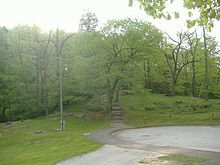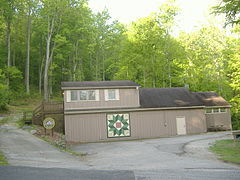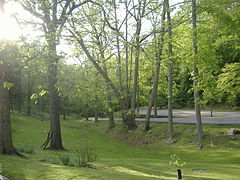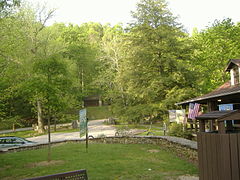Carter Caves State Resort Park
| Carter Caves State Resort Park | |
|---|---|
 Visitor Center | |
Location in Kentucky Location in United States | |
| Type | Kentucky state park |
| Location | Carter County, Kentucky |
| Coordinates | 38°22′26″N 83°07′20″W / 38.37389°N 83.12222°W |
| Area | 2,000 acres (810 ha)[1] |
| Elevation | 1,040 feet (320 m)[2] |
| Created | 1946[1] |
| Operated by | Kentucky Department of Parks |
| Open | March 1st to Nov 1st |
| Website | parks |
Carter Caves State Resort Park is located in Carter County, Kentucky, United States, along Tygarts Creek. It is formed by Carter Caves, and nearby Cascade Caves, which were added to the park in 1959.[3] On December 16, 1981, 146 acres (59 ha) of the park were designated as nature preserves. Bat Cave and Cascade Caverns State Nature Preserves were dedicated for the protection of the Indiana bat, mountain maple, and Canada yew, all endangered species.[4]
History
[edit]The park was in various private hands for almost 200 years until the last private family owners, the J.F. Lewis family and various other private investors, including local Rotary Clubs, donated the large tract of property (945 acres (382 ha))[1] to the Commonwealth of Kentucky in 1946.[5] The purchase of the caves and surrounding land was driven by Governor William Jason Fields, a native of Carter County.[3]
Attractions
[edit]Resort park
[edit]Carter Caves is a state resort park that features a lodge, cottages, 18-hole putt-putt course, full-service campground (18 sites with sewer hook-ups), and 26 miles (42 km) of hiking trails, cave tours available year-round, and seasonal horse riding stables.[6]
Caves
[edit]
There are several cave tours offered. Guided tours of Cascade Cave and X-Cave are available year-round. Bat Cave and Saltpetre Cave are only open in the summer, and close during the winter hibernation season due to the threat of white nose syndrome, a disease which threatens several endangered species of bats.
Cascade Cave is the name for three different caves in the same area and is together the largest cave in the park. It features an underground lake room and an 30-foot (9.1 m) underground waterfall.
X Cave, named for the crossing pattern of its passages, features some of the largest rock formations in the park.
Saltpetre Cave was mined during the War of 1812 because saltpetre, or potassium nitrate, is a major component in gunpowder. Historic activities are a major part of the Saltpetre Cave tour. Bat Cave is also toured in the summer months, between Memorial Day and Labor Day, and is considered a "wild" cave tour since the cave has not been improved for walking tours. The cave is unique in that it is a hibernaculum for the endangered Indiana bat in the winter months.[7]
Laurel Cave is the most visited of the non-commercial caves in the park, and contains some of the most interesting passages. Laurel Cave is open to the public during regular business hours in the summer months only (Memorial Day - Labor Day). All that is required is a permit available at the Welcome Center/Gift Shop. The permit gives you legal access to Laurel Cave (summer months only), Horn Hollow Caves and the connected Rimstone Cave.[8]
Trails
[edit]
Over thirty miles of hiking trails encounter seven natural bridges throughout the park. The Cascade Trail is a three-quarter mile trail passing through Box Canyon. The Three Bridges Trail winds three and a quarter miles and includes the park's largest natural bridge, the Smokey Bridge, which stands an impressive 90 feet (27 m) high and 120 feet (37 m) wide. This trail also passes by Fern Bridge and Raven Bridge as it meanders through the park. The half-mile Natural Bridge Trail passes beneath a third natural bridge, the only one in Kentucky that is paved and supports traffic. Longer trails include the 7.2-mile (11.6 km) Carter Caves Cross Country Trail (The 4Cs Trail) and the ten-mile (16 km) Kiser Hollow multi-access trail, which parallels the 4Cs trail for a couple of miles before encircling the outer boundaries of the park's property.
Smokey Valley Lake and Tygarts Creek
[edit]Smokey Valley Lake is a 45-acre (180,000 m2) lake within the park. Anglers will find populations of largemouth bass, bluegill, catfish, and crappie in the lake. The boat is accessible by ramp, but no gasoline motors are permitted.
Ecology
[edit]The cave system houses a variety of organisms including:
Gallery
[edit]-
Former Ranger station, now storage and laundry, midway between Visitor Center and Lodge
-
Roadway topography typical of the park
-
View of Saltpeter Cave from Visitor Center
See also
[edit]References
[edit]- ^ a b c "History". Carter Caves State Resort Park. Kentucky Department of Parks. Retrieved September 25, 2013.
- ^ "Carter Caves State Resort Park". Geographic Names Information System. United States Geological Survey, United States Department of the Interior.
- ^ a b Kleber, John E., ed. (1992). "Carter and Cascade Caves". The Kentucky Encyclopedia. Associate editors: Thomas D. Clark, Lowell H. Harrison, and James C. Klotter. Lexington, Kentucky: The University Press of Kentucky. ISBN 978-0-8131-1772-0.
- ^ "Bat Cave State Nature Preserve". Kentucky State Nature Preserves Commission. Retrieved September 25, 2013.
- ^ Lewis, Jonathon F. (2004). Carter Caves State Resort Park: A Living History. Charleston, W.Va.: Chapman Printing.
- ^ "Carter Caves". Kentucky State Park. Retrieved September 23, 2020.
- ^ Bailey, Bill (1995). "Carter Caves State Resort Park". Kentucky State Parks. Saginaw, Michigan: Glovebox Guidebooks of America. ISBN 978-1-881139-13-3.
- ^ "Dictionary of Places - Carter Caves and Natural Bridges". Encyclopedia of Kentucky. New York, New York: Somerset Publishers. 1987. ISBN 978-0-403-09981-8.
- ^ a b c d e f g h i j k l m n o p q r s t u v w x y z aa ab ac ad ae af ag ah ai aj ak al am an ao ap aq ar as at au av aw ax ay az ba bb bc bd be bf bg bh bi bj bk bl bm bn bo bp bq br Conn, David Bruce (1981). Cave Life of Carter Caves State Park. Morehead, Kentucky: Appalachian Development Center.
- ^ a b c d e f g h i j k l m n o p Conn, David Bruce; DeMoss, Gerald L. (1980). "Preliminary studies on the cavernicolous invertebrates of Carter Caves, Kentucky". ResearchGate. Kentucky Academy of Science Zoology and Entomology Section. Retrieved January 23, 2019.
- ^ Miller, Jerome S.; Quay, W. B. (August 1, 1955). "Occurrence of the Red Bat, Lasiurus borealis, in Caves". Journal of Mammalogy. 36 (3): 454–455. doi:10.2307/1375691. ISSN 0022-2372. JSTOR 1375691.
- ^ Barbour, Roger W.; Davis, Wayne H. (January 13, 2015). Mammals Of Kentucky. University Press of Kentucky. ISBN 9780813156477.
- ^ Goslin, Robert M. (January 1964). "The Gray Bat, Myotis grisescens Howell, from Bat Cave, Carter County, Kentucky". Ohio State Museum. hdl:1811/4982.
- ^ "Gray bat". biology.eku.edu. Retrieved January 22, 2019.
External links
[edit]- Carter Caves State Resort Park Kentucky Department of Parks










